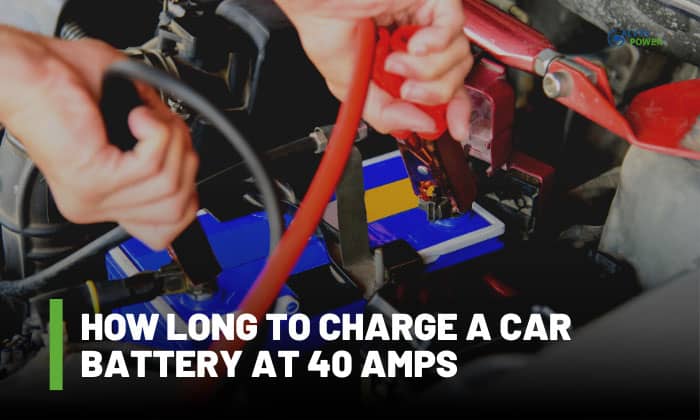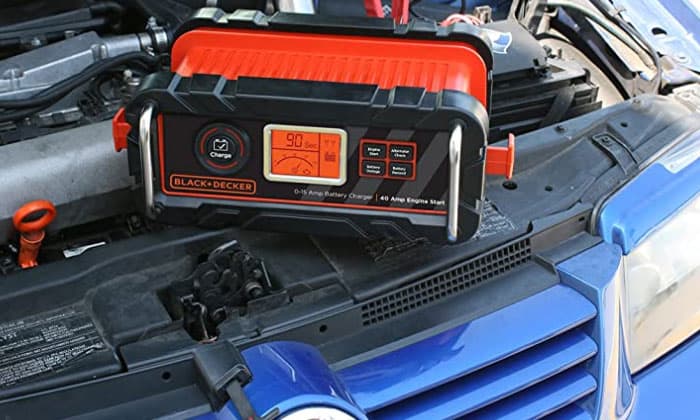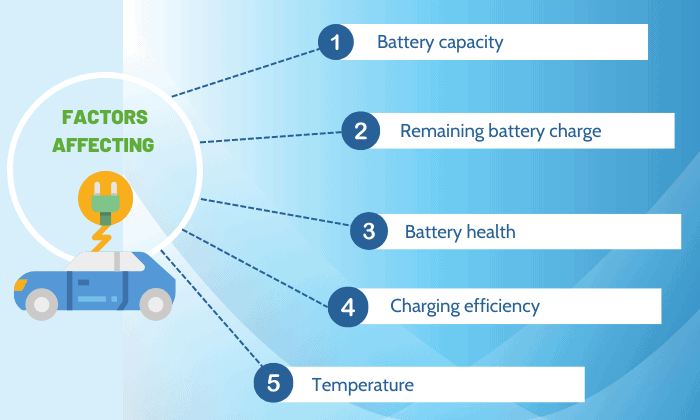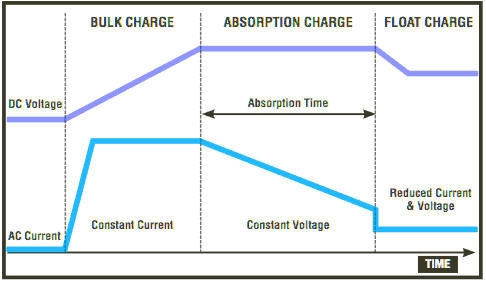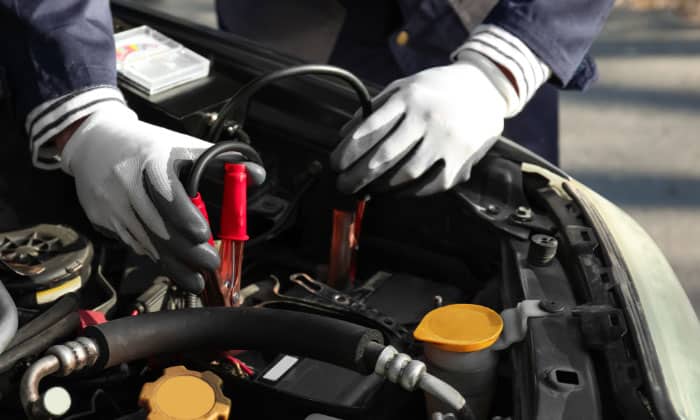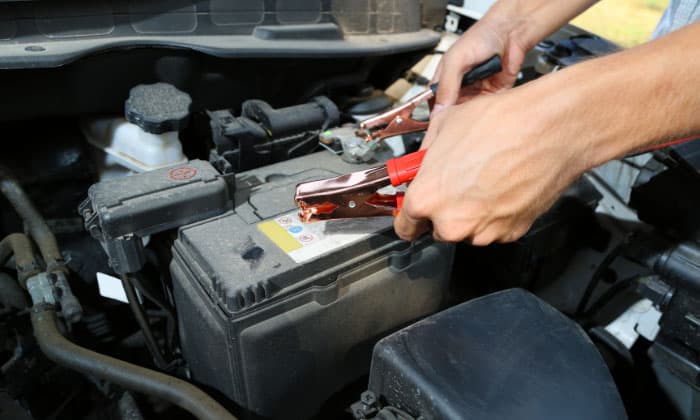40 amp chargers are great for fast charging and can shorten the time it takes to power up your vehicle. But they also run the risk of damaging your car battery if left for too long. That’s why we have to watch out for how long to charge a car battery at 40 amps.
Generally, it takes around 1 hour and 12 minutes to charge a 48 amp-hour car battery. Charging time is also longer for higher battery capacities.
Table of Contents
Overview of a 40 Amp Car Battery Charger
40 amp chargers for lead acid batteries are commonly used in vehicles with large power capacities like pallet lifts, golf carts and floor scrubbers, as well as boats and helicopters. They can also be used to recharge a dead car battery in a shorter time than standard car chargers.
Time Required to Charge at 40 Amps
We can estimate how long to fully charge a car battery with a 40 amp charger using the amp-hour rating of the battery. The estimated time is:
\[ \text{time (hr)} = \frac{\text{Battery capacity (amp$\cdot$hr)}}{\text{Charging current (amps)}} \]
If we have a 48 amp-hour battery, then the time it takes to charge it with a 40 amp plug is:
\[ \text{time (hr)} = \frac{\text{Battery capacity (amp$\cdot$hr)}}{\text{Charging current (amps)}} = \frac{48 \, \text{amp$\cdot$hr}}{40 \, \text{amps}} = 1.2 \, \text{hr} \]
This is the fastest time a 40 amp charger can power a perfectly healthy 48 amp-hour battery. Of course, the actual duration depends on the factors we mentioned.
Factors Affecting Charging Time at 40 Amps
1. Battery capacity
A higher battery capacity in amp-hours takes longer to charge. A 48 amp-hour battery will take at least 1 hour and 12 minutes to charge, while a 75 amp-hour battery will take at least 1 hour and 52 minutes.
2. Remaining battery charge
A more depleted battery takes longer to charge. However, the charging rate slows down when we get close to 100%. This can be seen in this battery charge time chart:
3. Battery health
A battery with poorer health (sulfated batteries and those with plate shedding) reduce battery capacity. This means batteries with poorer health charge faster.
4. Charging efficiency
A more efficient battery can charge faster than a less efficient one. Generally, 30% of the charging energy is lost through current leakage and heating.
5. Temperature
Lower (32℉) and higher ambient temperatures (104 degrees) can extend charging times. Car batteries can charge best at 77⁰F (25⁰C).
Charging Time of Using a 40 Amp Charger Vs. Running the Car
A 40 amp charger can ideally ‘restore’ a 48 amp-hour lead acid battery in 1.2 hours, or 1 hour and 12 minutes. The maximum time to charge a car battery using a 40 amp charger is two hours. This much current might damage car batteries at longer charging times.
A car alternator, however, can charge vehicles while driving within 30 minutes to eight hours. Several factors can affect how long for car battery to charge with an alternator like poor battery health, running electric components, a low alternator current supply, and a large battery capacity.
The alternator pass charge to a car battery when there’s excess current. It can generate more energy if it operates at higher highway speeds (around 65 miles per hour), and only very little current when idle.
Frequently Asked Questions
Car battery charging overview
First, to understand how to charge a car battery, let’s talk about how it operates. We’ll focus on the 12V battery, which is commonly a lead acid battery that is made up of lead plates with a mixture of sulfuric acid.
When the car starts, a chemical reaction occurs between the lead plates and the sulfuric acid that releases electrons. These electrons flow and form the huge car battery amps to supply the starter motor and start the engine.
Once the engine is running, the car’s alternator kicks in. The alternator supplies current to the car’s electrical circuits as well as recharges the battery. The electricity supplied to the battery reverses the chemical reactions to allow the battery to discharge again on the next startup.
Steps to charge a car battery using a 40 amp charger
- Plug the charger.
- Disconnect the negative terminal of the car from the battery.
- Connect the positive and negative terminals of the charger to the right battery terminals.
- Set the output voltage of the charger to 12V and the battery type to WET or FLOODED if you’re using regular batteries, but you can choose a setting based on your existing unit.
- Start the car charger. Estimate the waiting time using the equation we showed earlier.
- When the car charger’s indicator signals that the battery is full, turn off the charger and disconnect the battery.
- Connect the negative terminal of the car back to the battery.
Troubleshooting your car battery charger
Sometimes, the car charger might not work. Before you buy a new one, do the following steps to troubleshoot your device:
- Check the battery’s electrical supply.
The outlet may be the issue. Try using another outlet to check if the charger works as normal.
- Check the charger for any damage or corrosion.
Check for any warped or broken parts on the charger. Look at the plug, the cables, and the connectors for signs of damage.
- Check the battery.
The battery might be faulty. Test the charger with a different battery.
- Check for dust and rust.
If you see dust and dirt accumulating on your charger, clean it first. Then try to use the device later.
Safety considerations when using a 40 amp charger
- For wet and flooded type car batteries, check the battery’s electrolyte level before charging and top up if needed.
- The connectors might spark and start a fire if you disconnect the battery from the charger while the latter is running. Make sure to unplug the charger first before disconnecting.
- Charge the battery in a well-ventilated area or outdoors. Gasses might be emitted by a wet or flooded-type car battery during charging, and fresh air helps minimize risks of an explosion when such a gas is released.
- Remove any accessory or jewelry while charging.
- Wear safety goggles, gloves, and aprons if you can.
Common mistakes and potential consequences of improper charging
Improper charging will shorten the life of the battery. Here are some mistakes you can avoid to maintain the battery’s performance:
- Overcharging the battery
Overcharging can damage the battery. It harms the battery plates and overheats the unit. A 40 amp charger can only be used for up to 2 hours.
- Undercharging the battery
Undercharging can cause sulfation in the battery. Sulfation occurs when permanent lead sulfate crystals are formed inside the battery. This condition can reduce the battery performance.
- Wrong water level
This is true for wet or flooded lead acid batteries. Too much or too little water can cause electrolyte dilution or sulfation.
Choosing the right charger
Several chargers are available in the market. Here are some tips to choose the right one for you:
- Know the type of battery you have.
Batteries come in different types: wet or flooded, sealed lead acid, and lithium batteries, among others. Choose the car charger that can power the type of battery you have.
- 40 amp chargers are for full charging.
Fast chargers are meant to charge your dead battery to full. If you only need to maintain battery charge, a trickle charger may be a better choice than a 40 amp one.
- Know the capacity of the battery.
A common rule to minimize overcharging is to have the amperage of a car battery charger between 10% to 30% of the battery’s capacity, which is often 40 to 65 Ah.
A 130 amp hour battery can use a charger with 40 amps to charge car battery. But a 40 amp charger can still be used with lower battery capacities – just be more mindful about overcharging.
How can I charge my car battery faster?
Use a 40 amp car battery charger or other fast chargers compatible with your power bank. Charge the battery at an ambient temperature of 77⁰F (25⁰C). You should also turn off all electricals in your vehicle to speed up the process.
Is it OK to charge a car battery overnight?
You can charge car battery overnight if you use trickle chargers. Trickle chargers are meant to supply small amounts of current to your battery so that overcharging and total power depletion don’t happen.
How can I extend the lifespan of my car battery?
To extend the usable life of your battery, keep the battery fully charged and clean it of dirt and corrosion frequently. Check our “Common Mistakes and Potential Consequences of Improper Charging” section as a guide.
What are the signs of a failing car battery?
If you have a failing battery, you may find it harder to start the car, the lights may dim, and the electronics may fail. These problems are worse during cold weather, and you might eventually smell sulfur gasses leaking from the battery.
Conclusion
40 amp chargers can help you get a dead car battery up and running in a short time. Of course, how long to charge a car battery at 40 amps will depend on several factors, like the battery capacity, its health, and the ambient temperature, among others.
Just remember to safely use 40 amp chargers and avoid the common mistakes we mentioned above. Following these tips can prolong your battery’s life and save you from an embarrassing breakdown somewhere along the road.

I am Edwin Jones, in charge of designing content for Galvinpower. I aspire to use my experiences in marketing to create reliable and necessary information to help our readers. It has been fun to work with Andrew and apply his incredible knowledge to our content.

